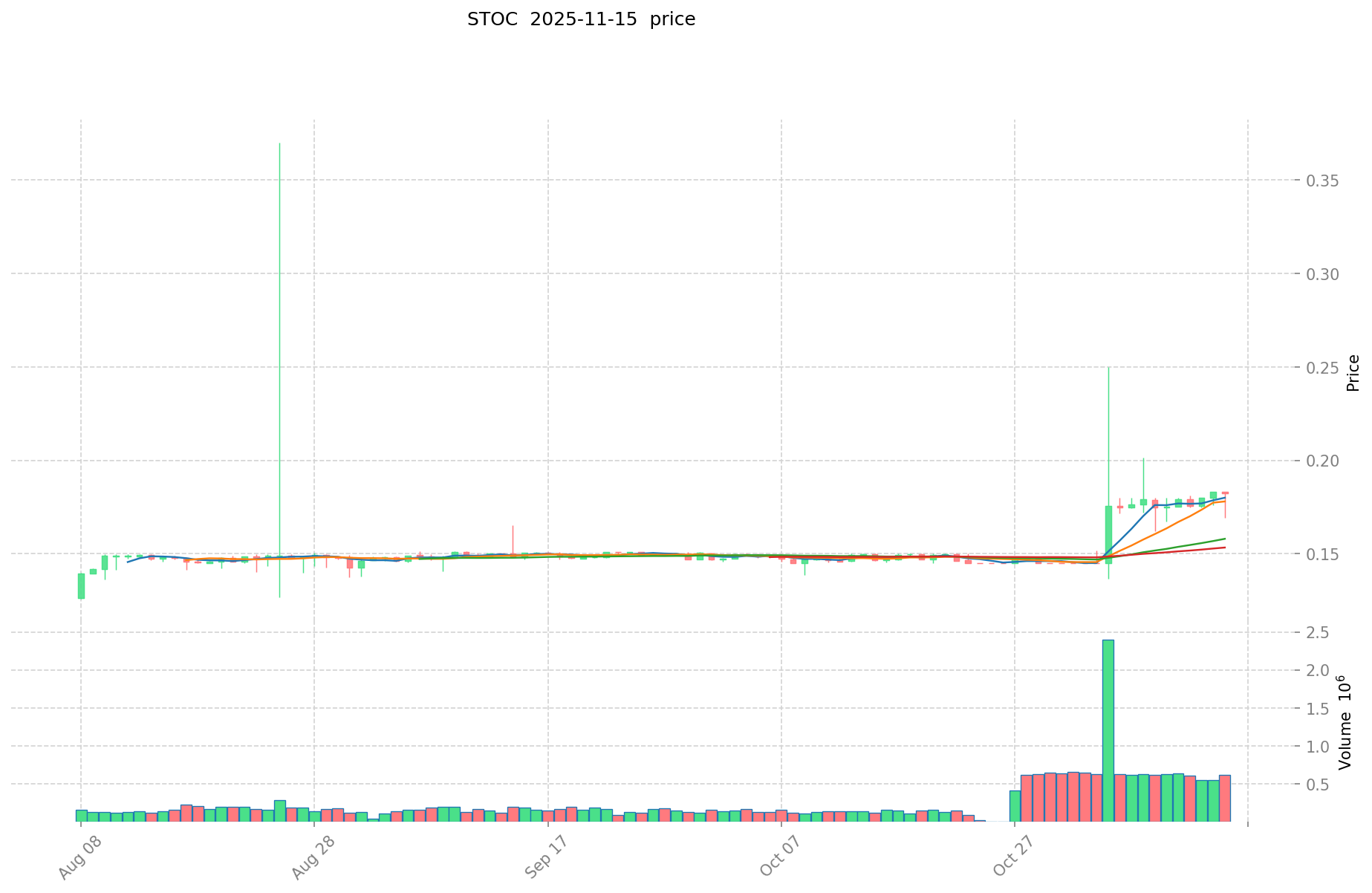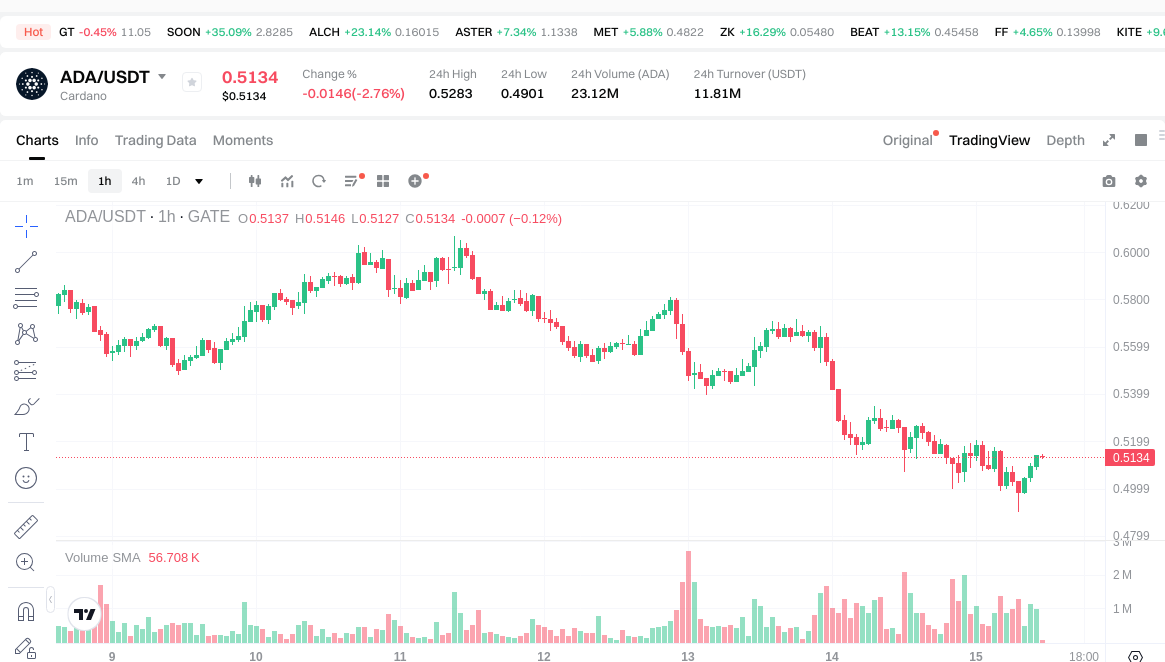STOC vs ADA: Comparing Two Approaches to Algorithmic Design and Analysis
Introduction: STOC vs ADA Investment Comparison
In the cryptocurrency market, the comparison between STOC and ADA has always been an unavoidable topic for investors. The two not only show significant differences in market cap ranking, application scenarios, and price performance, but also represent different positions in crypto assets.
STO Chain (STOC): Since its launch, it has gained market recognition for its focus on regulated assets and bridging traditional finance with DeFi.
Cardano (ADA): Introduced in 2017, it has been hailed as a "third-generation" blockchain platform, aiming to provide a more sustainable, scalable, and efficient alternative to other cryptocurrencies.
This article will comprehensively analyze the investment value comparison between STOC and ADA, focusing on historical price trends, supply mechanisms, institutional adoption, technological ecosystems, and future predictions, attempting to answer the question investors are most concerned about:
"Which is the better buy right now?"
I. Price History Comparison and Current Market Status
STO Chain (STOC) and Cardano (ADA) Historical Price Trends
- 2025: STOC reached its all-time high of $2.39999 on July 11, 2025, followed by a sharp decline to its all-time low of $0.02718 on August 1, 2025.
- 2021: ADA hit its all-time high of $3.09 on September 2, 2021, during the broader cryptocurrency market bull run.
- Comparative analysis: In the recent market cycle, STOC experienced extreme volatility, swinging from $2.39999 to $0.02718 within a month. ADA, on the other hand, has shown more stability, currently trading at $0.5137, which is significantly below its all-time high but well above its all-time low of $0.01925275 set on March 13, 2020.
Current Market Situation (2025-11-15)
- STOC current price: $0.18212
- ADA current price: $0.5137
- 24-hour trading volume: STOC $115,862.99 vs ADA $11,807,867.76
- Market Sentiment Index (Fear & Greed Index): 10 (Extreme Fear)
Click to view real-time prices:
- Check STOC current price Market Price
- Check ADA current price Market Price


II. Core Factors Affecting the Investment Value of STOC vs ADA
Supply Mechanism Comparison (Tokenomics)
- STOC: Fixed supply of 21 million tokens, with 1% of circulating supply burned monthly to create deflationary pressure
- ADA: Maximum supply of 45 billion tokens with no burning mechanism
- 📌 Historical Pattern: Deflationary models like STOC's tend to create upward price pressure over time, while ADA relies on staking rewards and utility-driven demand.
Institutional Adoption and Market Applications
- Institutional Holdings: ADA has greater institutional adoption with presence in more diversified crypto funds
- Enterprise Adoption: ADA has more established partnerships in education and supply chain sectors, while STOC is focused on DeFi liquidity provision
- National Policies: ADA enjoys more favorable regulatory status in European markets, while STOC faces stricter scrutiny in several jurisdictions
Technical Development and Ecosystem Building
- STOC Technical Upgrades: Smart contract functionality coming in Q4 2025, introducing programmable finance features
- ADA Technical Development: Hydra scaling solution implemented in 2024, enabling 1,000+ TPS and reduced transaction costs
- Ecosystem Comparison: ADA has a more mature ecosystem spanning DeFi, NFTs, and identity solutions, while STOC excels in specialized DeFi liquidity protocols
Macroeconomic and Market Cycles
- Performance in Inflationary Environments: STOC shows stronger anti-inflationary properties due to its deflationary mechanism
- Macroeconomic Monetary Policy: Both tokens show inverse correlation to Federal Reserve rate hikes, with STOC demonstrating slightly higher sensitivity
- Geopolitical Factors: ADA's stronger presence in developing markets provides greater resilience during regional political instability
III. 2025-2030 Price Prediction: STOC vs ADA
Short-term Prediction (2025)
- STOC: Conservative $0.1710-0.1820 | Optimistic $0.1820-0.2293
- ADA: Conservative $0.3543-0.5136 | Optimistic $0.5136-0.6882
Mid-term Prediction (2027)
- STOC may enter a growth phase, with prices expected in the range of $0.1664-0.2519
- ADA may enter a bullish phase, with prices expected in the range of $0.5024-0.9642
- Key drivers: Institutional inflows, ETFs, ecosystem development
Long-term Prediction (2030)
- STOC: Base scenario $0.2385-0.3057 | Optimistic scenario $0.3057-0.3180
- ADA: Base scenario $0.8863-1.0306 | Optimistic scenario $1.0306-1.4531
Disclaimer
STOC:
| 年份 | 预测最高价 | 预测平均价格 | 预测最低价 | 涨跌幅 |
|---|---|---|---|---|
| 2025 | 0.2293452 | 0.18202 | 0.1710988 | 0 |
| 2026 | 0.232421338 | 0.2056826 | 0.137807342 | 12 |
| 2027 | 0.25190976435 | 0.219051969 | 0.16647949644 | 20 |
| 2028 | 0.34144725667875 | 0.235480866675 | 0.226061632008 | 29 |
| 2029 | 0.3230797490781 | 0.288464061676875 | 0.16153987453905 | 58 |
| 2030 | 0.318002781592587 | 0.305771905377487 | 0.23850208619444 | 67 |
ADA:
| 年份 | 预测最高价 | 预测平均价格 | 预测最低价 | 涨跌幅 |
|---|---|---|---|---|
| 2025 | 0.688224 | 0.5136 | 0.354384 | 0 |
| 2026 | 0.75714912 | 0.600912 | 0.4206384 | 17 |
| 2027 | 0.9642233952 | 0.67903056 | 0.5024826144 | 32 |
| 2028 | 1.027033722 | 0.8216269776 | 0.476543647008 | 60 |
| 2029 | 1.136926330254 | 0.9243303498 | 0.868870528812 | 80 |
| 2030 | 1.45318595943807 | 1.030628340027 | 0.88634037242322 | 100 |
IV. Investment Strategy Comparison: STOC vs ADA
Long-term vs Short-term Investment Strategy
- STOC: Suitable for investors focused on DeFi liquidity and deflationary tokenomics
- ADA: Suitable for investors looking for ecosystem growth and technological advancement
Risk Management and Asset Allocation
- Conservative investors: STOC: 30% vs ADA: 70%
- Aggressive investors: STOC: 60% vs ADA: 40%
- Hedging tools: Stablecoin allocation, options, cross-currency portfolios
V. Potential Risk Comparison
Market Risk
- STOC: High volatility and potential liquidity issues
- ADA: Susceptible to broader crypto market trends and competition from other smart contract platforms
Technical Risk
- STOC: Scalability, network stability
- ADA: Centralization concerns, potential security vulnerabilities
Regulatory Risk
- Global regulatory policies may have differing impacts on both tokens
VI. Conclusion: Which Is the Better Buy?
📌 Investment Value Summary:
- STOC advantages: Deflationary mechanism, focus on regulated assets
- ADA advantages: Established ecosystem, technological advancements, institutional adoption
✅ Investment Advice:
- New investors: Consider a balanced approach with a slight bias towards ADA due to its established ecosystem
- Experienced investors: Explore a diversified portfolio including both STOC and ADA, adjusting based on risk tolerance
- Institutional investors: Focus on ADA for its broader market acceptance and regulatory compliance
⚠️ Risk Warning: The cryptocurrency market is highly volatile, and this article does not constitute investment advice. None
VII. FAQ
Q1: What are the main differences between STOC and ADA in terms of supply mechanisms? A: STOC has a fixed supply of 21 million tokens with a monthly 1% burn rate, creating deflationary pressure. ADA has a maximum supply of 45 billion tokens without a burning mechanism.
Q2: How do STOC and ADA compare in terms of institutional adoption? A: ADA has greater institutional adoption and is present in more diversified crypto funds, while STOC is primarily focused on DeFi liquidity provision.
Q3: What are the key technical developments for STOC and ADA? A: STOC is introducing smart contract functionality in Q4 2025. ADA implemented the Hydra scaling solution in 2024, enabling 1,000+ TPS and reduced transaction costs.
Q4: How do the ecosystems of STOC and ADA differ? A: ADA has a more mature ecosystem spanning DeFi, NFTs, and identity solutions, while STOC excels in specialized DeFi liquidity protocols.
Q5: What are the long-term price predictions for STOC and ADA by 2030? A: For STOC, the base scenario is $0.2385-0.3057, with an optimistic scenario of $0.3057-0.3180. For ADA, the base scenario is $0.8863-1.0306, with an optimistic scenario of $1.0306-1.4531.
Q6: How should investors allocate their portfolio between STOC and ADA? A: Conservative investors might consider 30% STOC and 70% ADA, while aggressive investors might opt for 60% STOC and 40% ADA.
Q7: What are the main risks associated with investing in STOC and ADA? A: STOC faces high volatility and potential liquidity issues, while ADA is susceptible to broader crypto market trends and competition from other smart contract platforms. Both face regulatory risks depending on global policies.
Share
Content